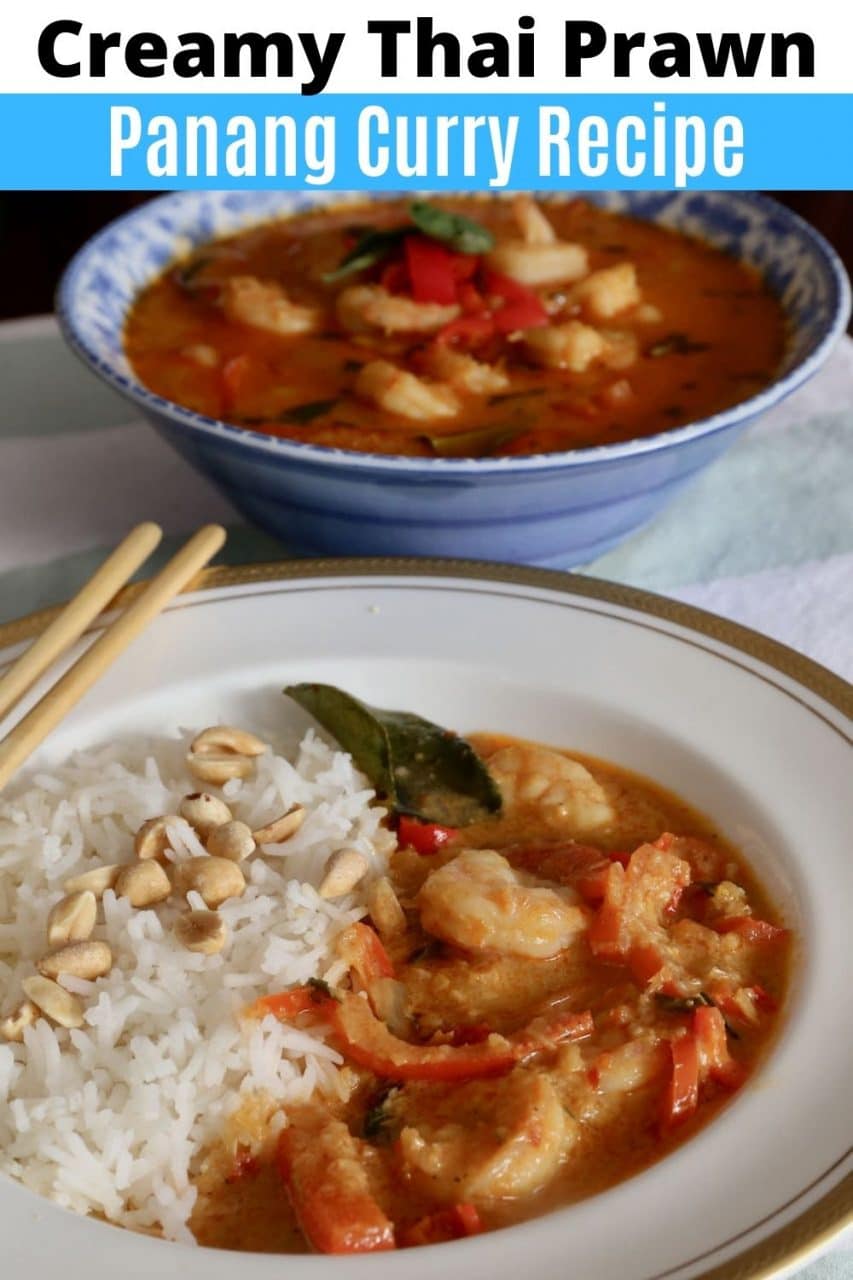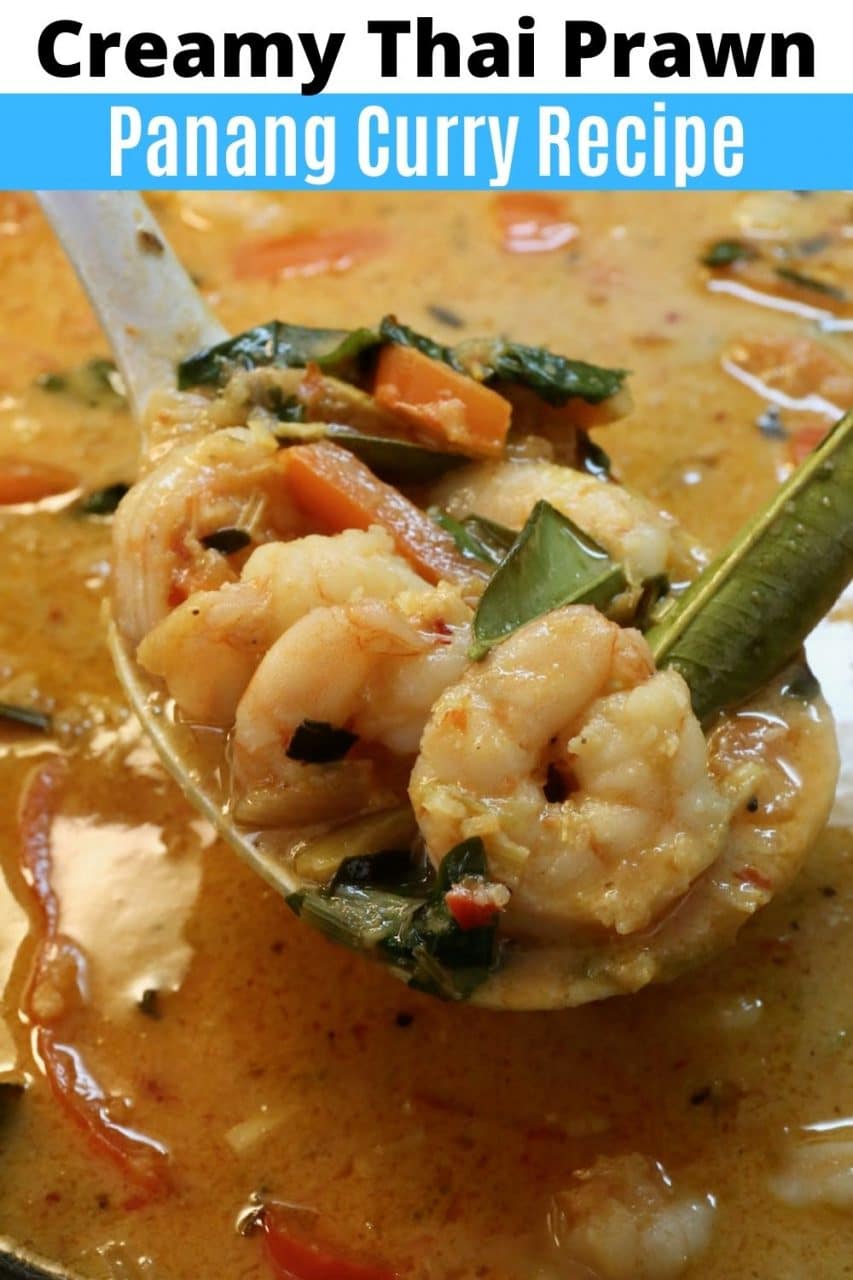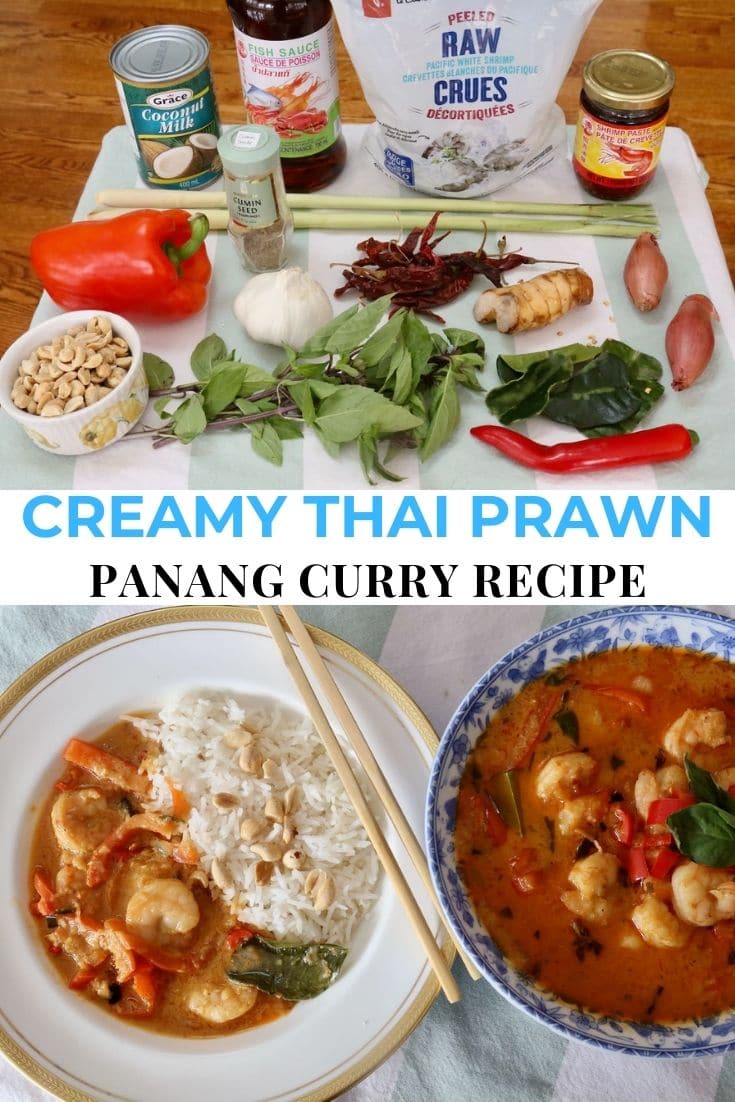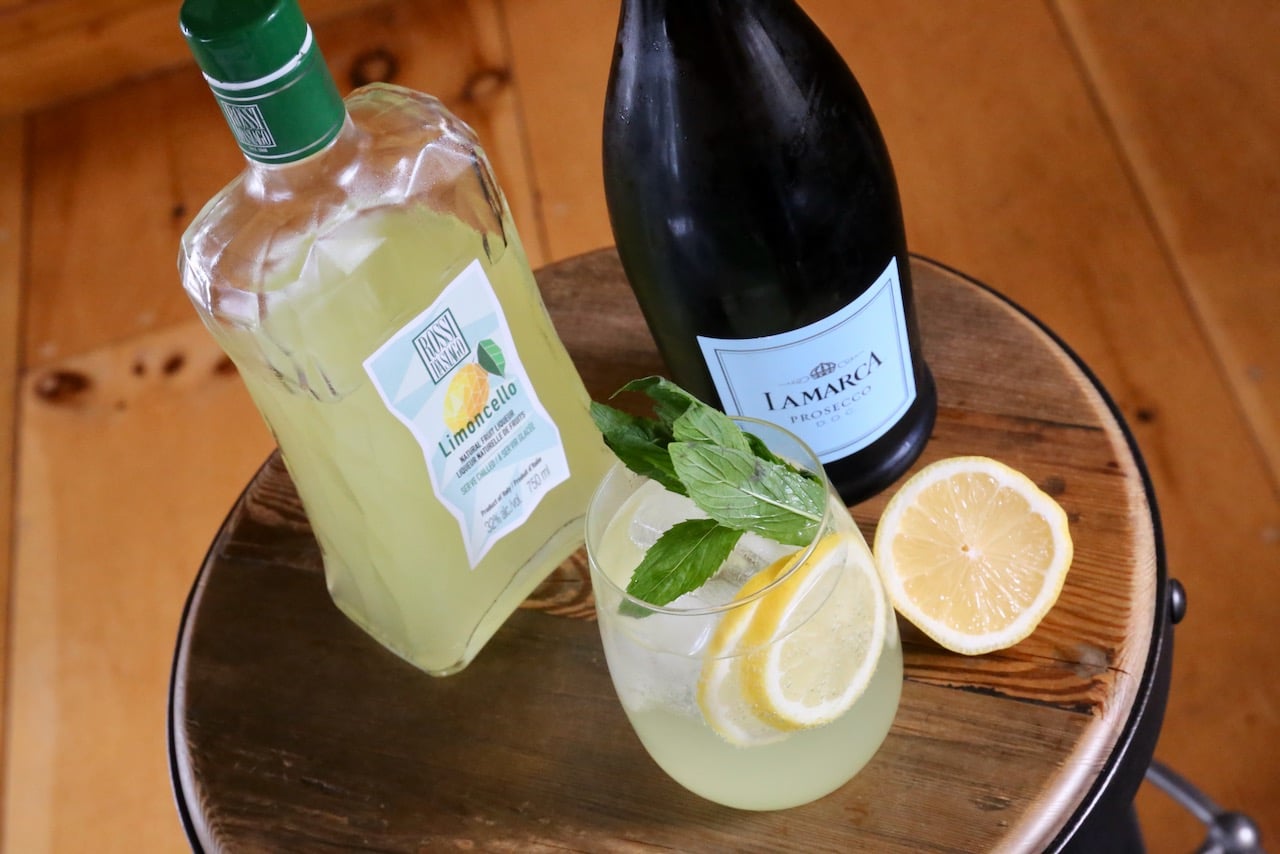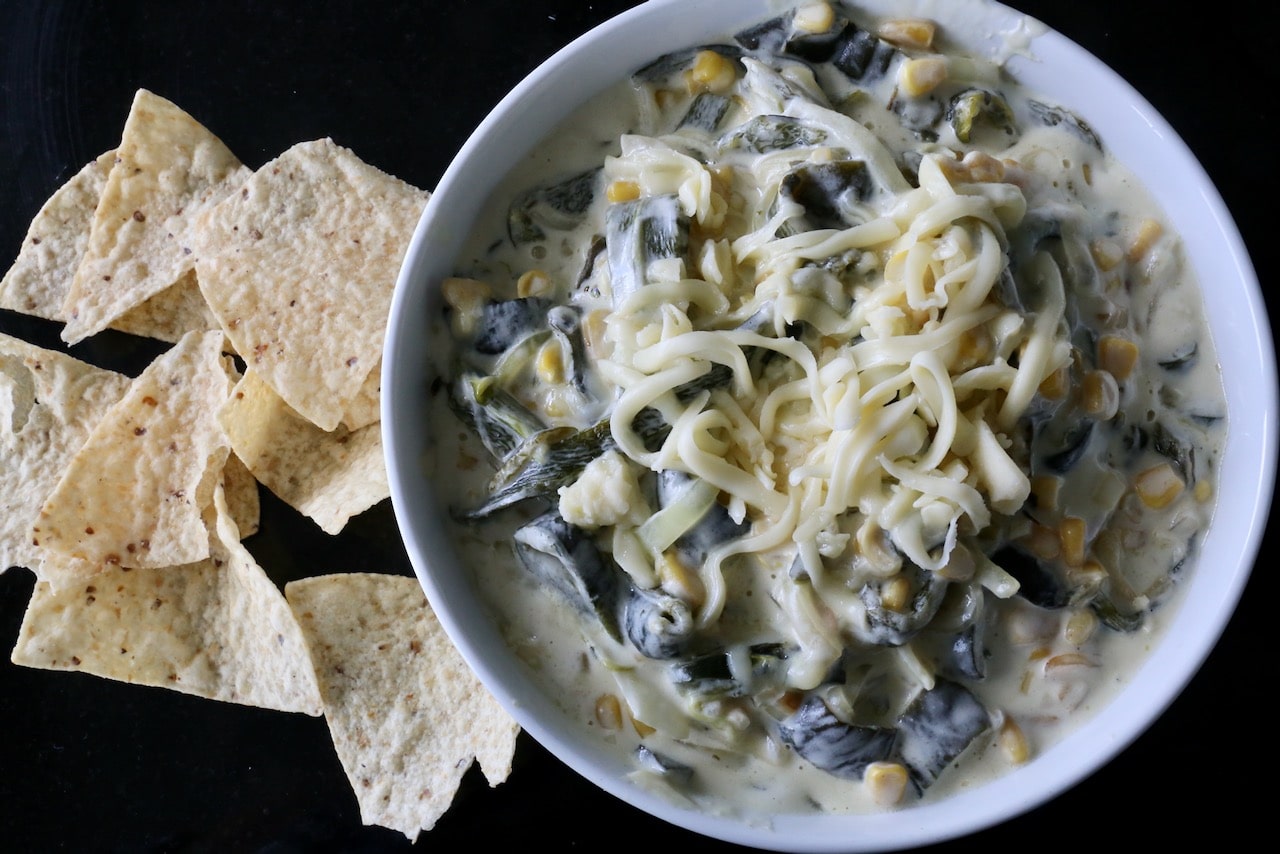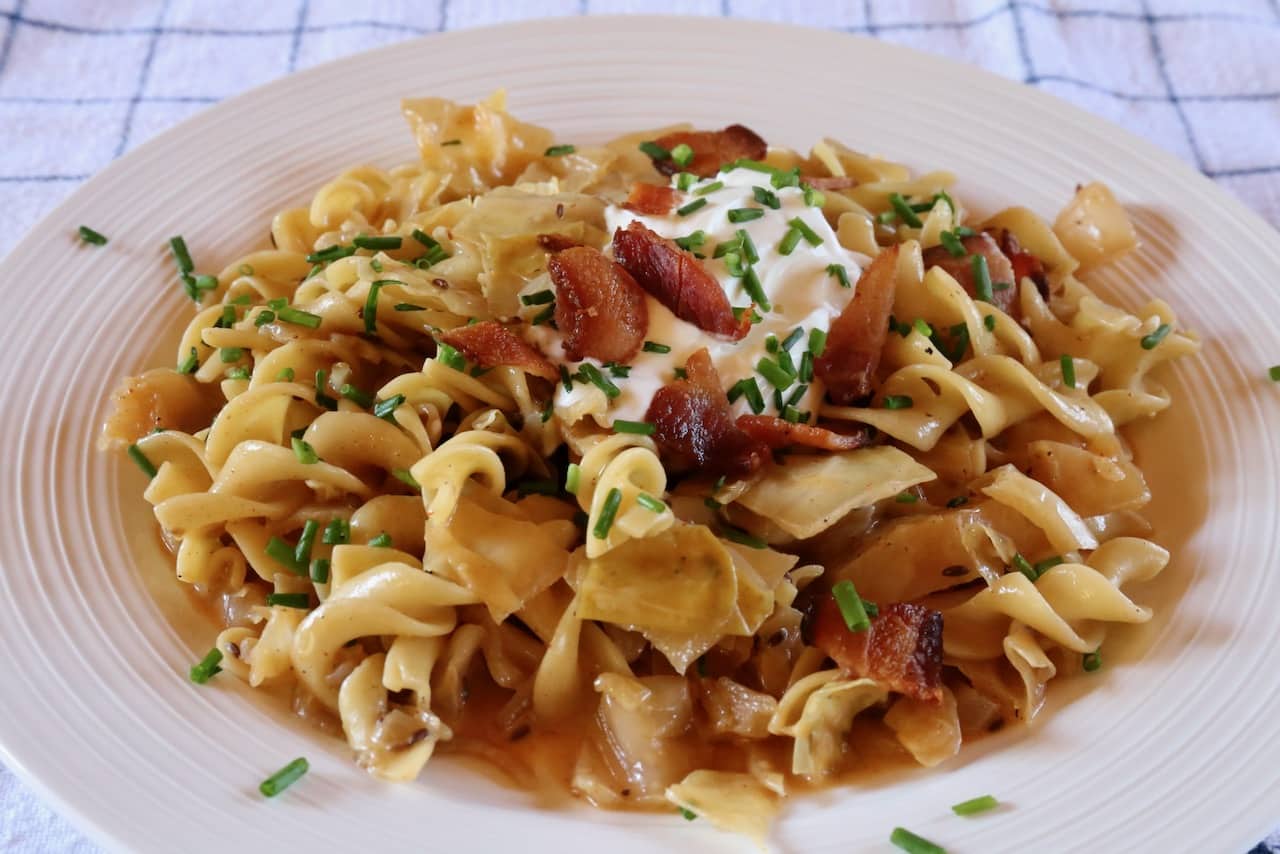Prawn Panang Curry is a creamy coconut seafood stew from Southern Thailand.
Prawn Penang Curry, also known as Shrimp Panang Curry, is a decadent rich comfort food recipe that is typically served in restaurants as a main course or entree with steamed jasmine rice.
Traditional recipes feature ingredients like Panang curry paste, shrimp or prawns, red bell pepper, coconut cream, brown sugar, fish sauce, lime leaves, Thai basil leaves, long red chili and roasted peanuts.
We’ve traveled extensively through Thailand and eaten at all of the best Thai restaurants in Toronto. We’ve taken Thai cooking classes in Chang Mai and learned expert cooking techniques courtesy of the executive chef at JW Marriott Phuket Resort.
Cooking Thai food at home is quick and easy. We suggest doubling this recipe as we know you’ll love loitering over Prawn Panang Curry leftovers all week!
Save this story to Pinterest!
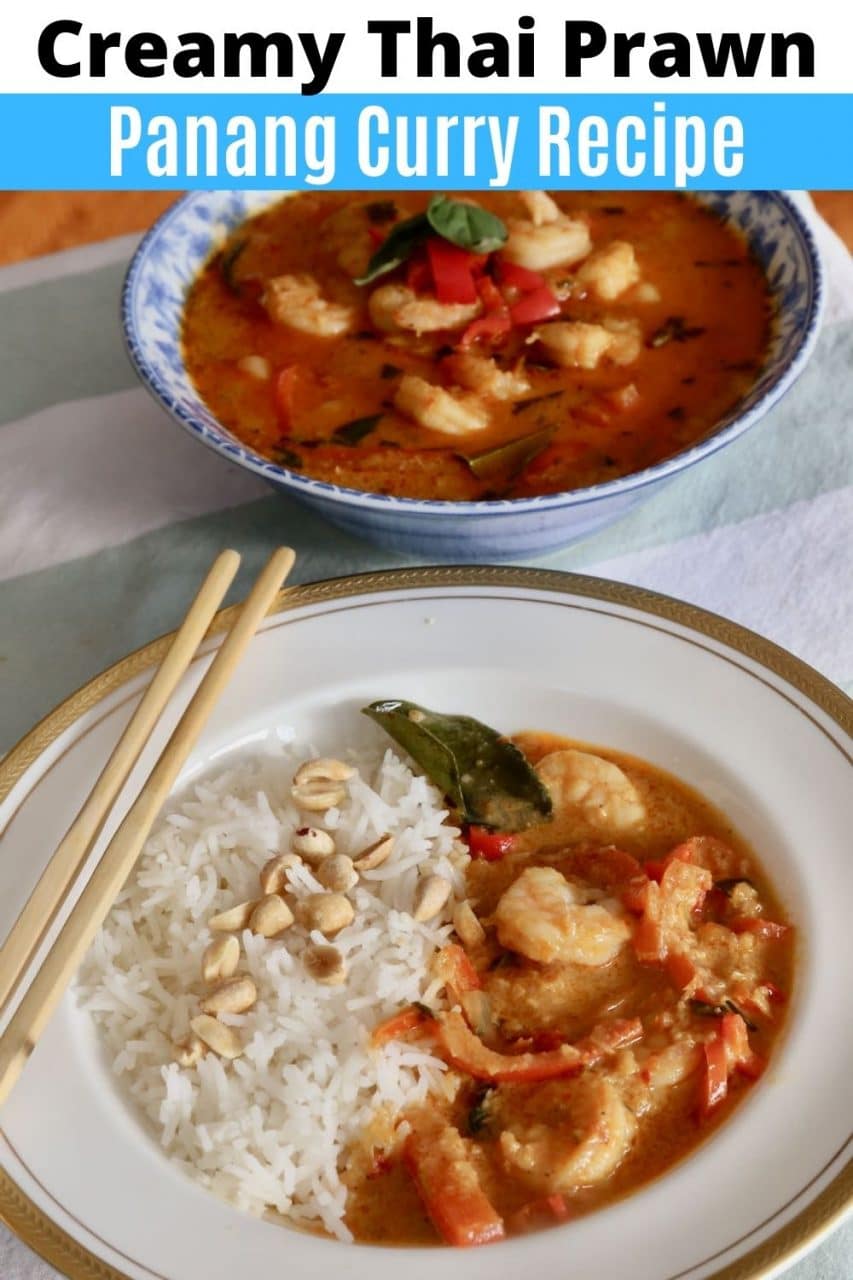
What Is Panang Curry?
Panang, also spelled phanang and phanaeng, is a type of Thai curry that is thick, salty and sweet, with a zesty makrut lime flavour.
The earliest known mention of panang curry appears in Mom Somchin Rachanupraphan’s book Tamra Kap Khao, published in 1890.
The traditional Thai curry paste is typically prepared with dried chili peppers, galangal, lemongrass, lime leaf, cilantro root, coriander seeds, cumin seeds, garlic, shallot, shrimp paste, salt and peanuts.
The curry paste is authentically prepared with meat or seafood, that is cooked with lime leaves, coconut cream, palm sugar and fish sauce. It typically contains thick coconut cream, making it one of the creamiest authentic Thai curries.
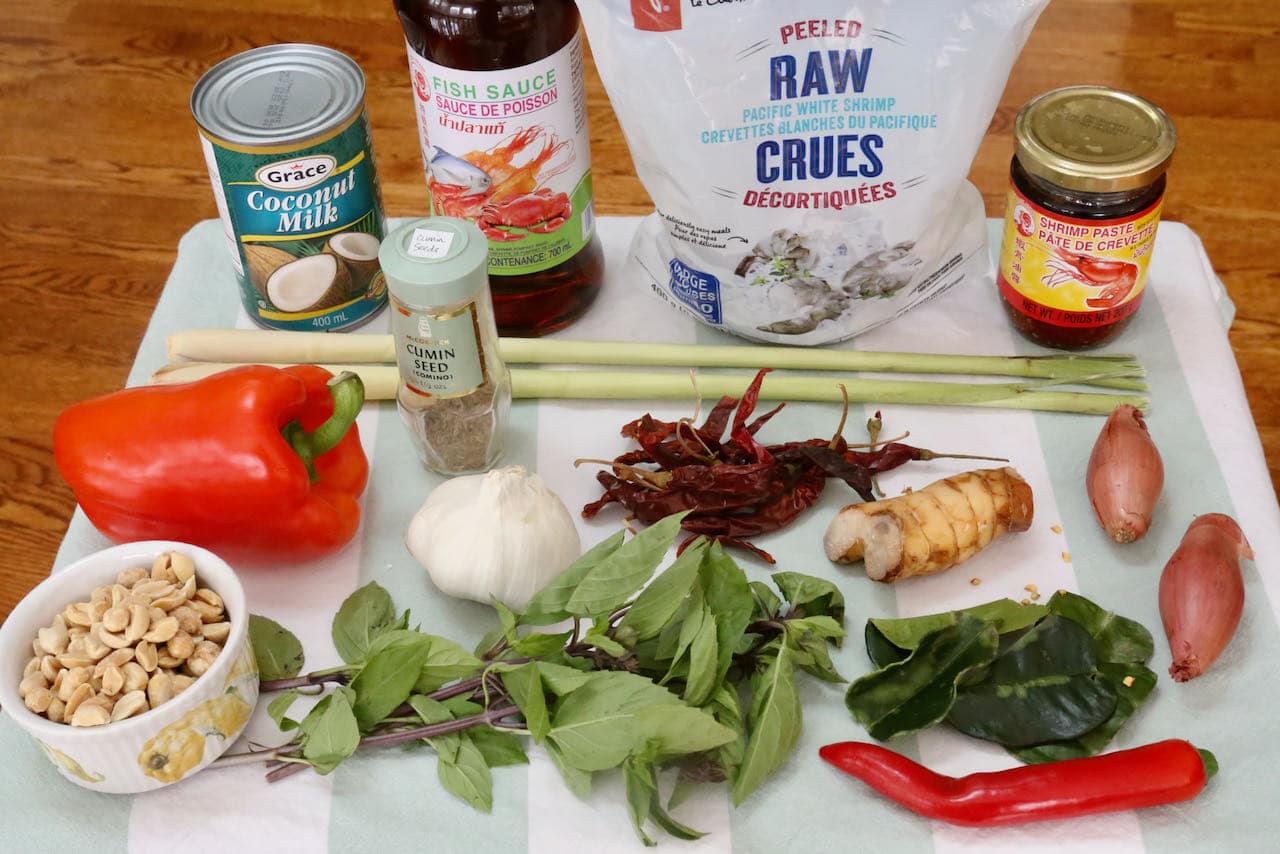
Travel to Thailand by Cooking Prawn Curry at Home
I love traveling through Asia.
My first visit had me living in South Korea for a year as a teacher and it’s where I was first introduced to fermented vegetables like kimchi.
After my contract ended in Seoul I travelled throughout southeast Asia for 6 months, visiting Philippines, Indonesia, Malaysia, Singapore, Cambodia, Myanmar, Thailand, Vietnam and Laos.
On my first visit I spent over a month backpacking through Thailand. I’ve revisited Thailand two times since as a food and travel journalist and always love to discover new regional dishes. Over the years I’ve explored Thai destinations such as Ko Phi Phi, Krabi, Chiang Khong, Chang Mai, Sukothai and Bangkok.
What I found most fascinating is Thailand’s distinct regional food cultures. Much like the regional cuisines found in Germany, Italy or Spain, each town in Thailand had its own local speciality.
Prawn Panang Curry is a dish most commonly cooked in Southern Thailand. Fresh seafood is bountiful throughout the postcard-perfect beaches of Thailand’s tropical islands. Our favourite way to cook with Panang curry paste at home is by using large shrimp or prawns.
You May Also Enjoy Reading…
- Things to Do When Beach Hopping in Thailand
- Phulay Bay Ritz-Carlton Reserve in Krabi
- Amari Vogue Krabi Luxury Resort in Thailand
- Four Seasons Resort Koh Samui
- The Tongsai Bay Luxury Resort in Koh Samui
- W Koh Samui Luxury Resort in Thailand
- Amari Resort Koh Samui in Thailand
- Amari Phuket Luxury Resort in Thailand
- 10 Must Try Tastes in Thailand
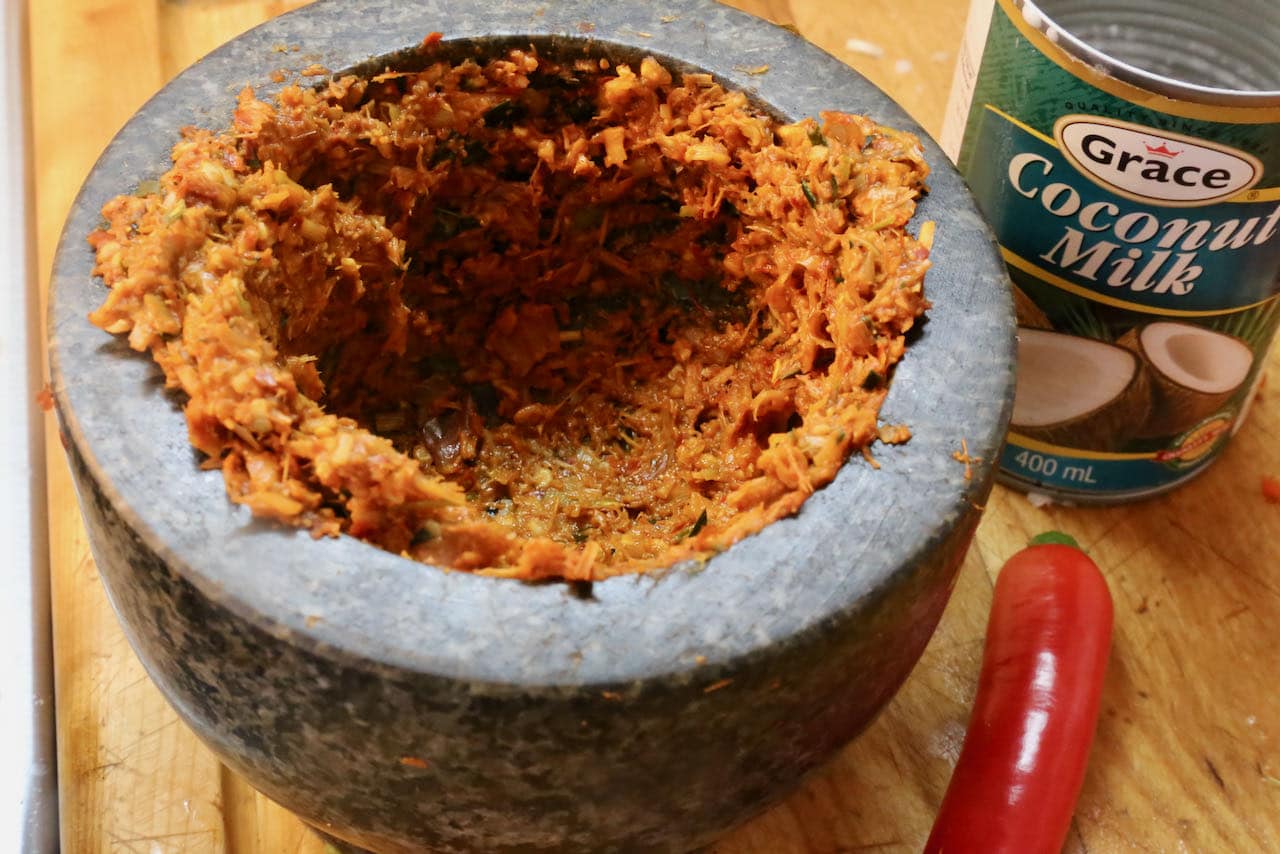
Where To Eat Shrimp Panang Curry?
If you live in a large city in Canada or America you’ll likely have access to a local Thai restaurant that serves traditional Prawn Panang Curry.
Haven’t traveled to Thailand before? It may be helpful to first taste Shrimp Panang Curry at a local Thai restaurant to better understand how the dish is served. You can also assess what vegetables the chef added to the stew, ideal coconut cream to shrimp ratio and get ideas on other Thai dishes to serve alongside the popular entree.
I spent months researching the best Thai restaurants in Toronto, visiting popular restaurants that serve authentic Thai dishes such as Sabai Sabai, Sukothai, Khao San Road, Pai, Kiin, Bangkok Garden, Mengrai Thai and Favorites Thai BBQ. If you’re looking to sample authentic Prawn Panang Curry in Toronto try visiting one of these award-winning restaurants.
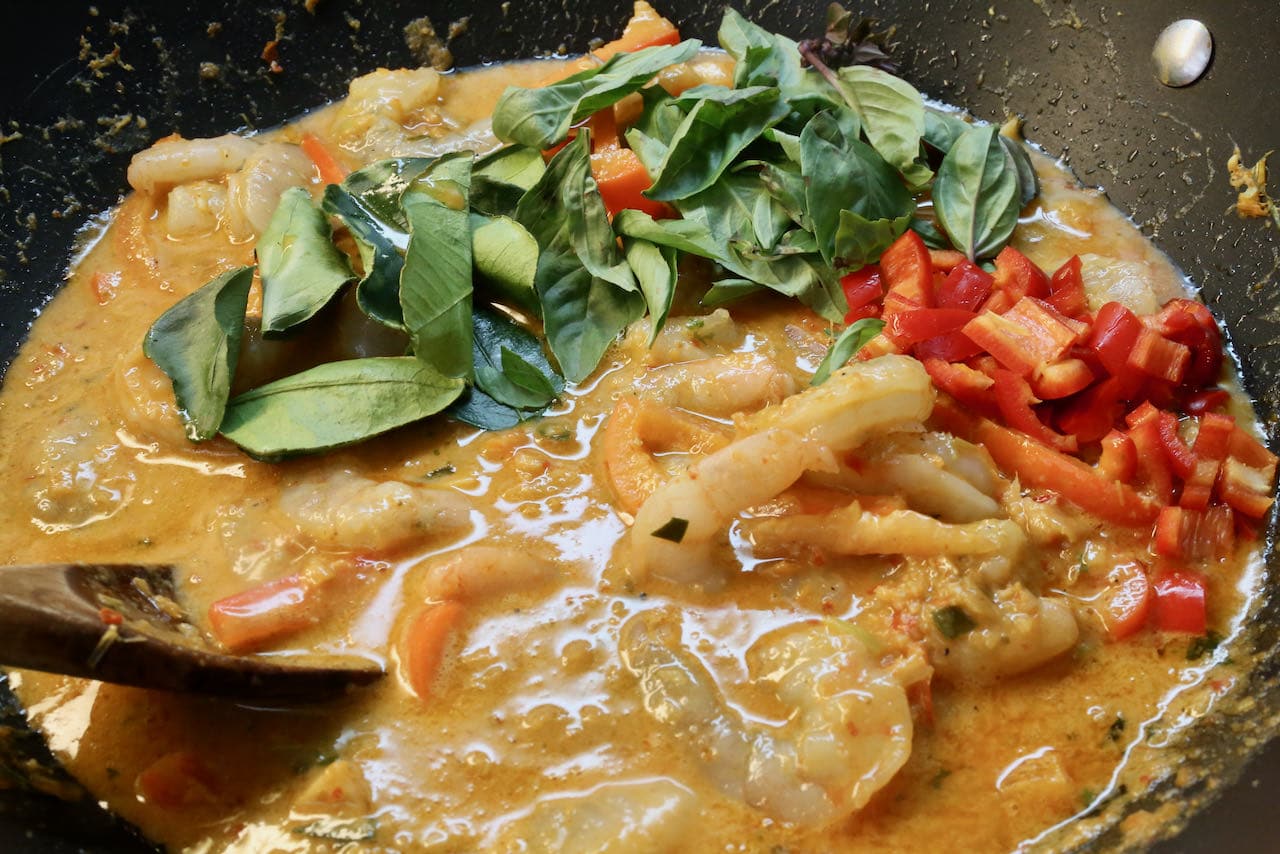
Prawn Panang Curry Health Benefits
Our Shrimp Panang Curry recipe is packed full of healthy ingredients!
Coconut is rich in fibre and may also offer a number of benefits including improved heart healthy and digestion. It is high in calories and sautéed fat so be sure to eat in moderation.
A rich source of phytochemicals and vitamin C, limes help boost your immune system and neutralize free radicals that cause disease and skin aging. Lemons also protect against heart disease and help improve blood flow to the brain.
Chili has been proven to help reduce the duration of sickness, prevent heart disease, and promote weight loss.
The eugenol in basil can block calcium channels, which may help to lower blood pressure. The essential oils in the herb can help to lower your cholesterol and triglycerides. Basil also contains magnesium, which can help to improve blood flow by allowing muscles and blood vessels to relax.
A rich source of blood-building iron, cumin may also help balance your blood sugar levels and reduce bad cholesterol. It is also traditionally used as a digestive aid.
A good source of bone-strengthening vitamin K, cilantro is also rich in antioxidants that help protect the eyes from damage by free radicals.
Lemongrass is a rich source of antioxidants. It’s an effective antibacterial and anti-fungal agent.
Galangal contains at least 14 phytochemicals, many of which have impressive antioxidant and anti-inflammatory properties. It also has a good source of copper, which supports your bones, blood and nervous system.
It is only recently that scientists have begun to identify the components responsible for garlic’s myriad health benefits. Rich in phytochemicals and potassium, garlic helps boost your immune system, fight cancer and protect your heart.
Onions are a humble vegetable packed with vitamins, minerals and phytochemicals. Regular consumption of onions can help boost digestive health and reduce the risk of developing heart disease.
Peanuts are rich in protein, fat, and fibre. While peanuts may have a large amount of fat, most of the fats they contain are known as “good fats.”
Seafood is a high-protein food that is low in calories, total fat, and saturated fat. High in vitamins and minerals, seafood has been shown to have numerous health benefits including decreasing the risk of heart attack, stroke, obesity, and hypertension.
Bell Peppers are an incredible source of vitamins C and A, which support your skin and immune system. They also provide beneficial carotenoid compounds such as beta-carotene, which has been shown to reduce the risk of certain cancers.
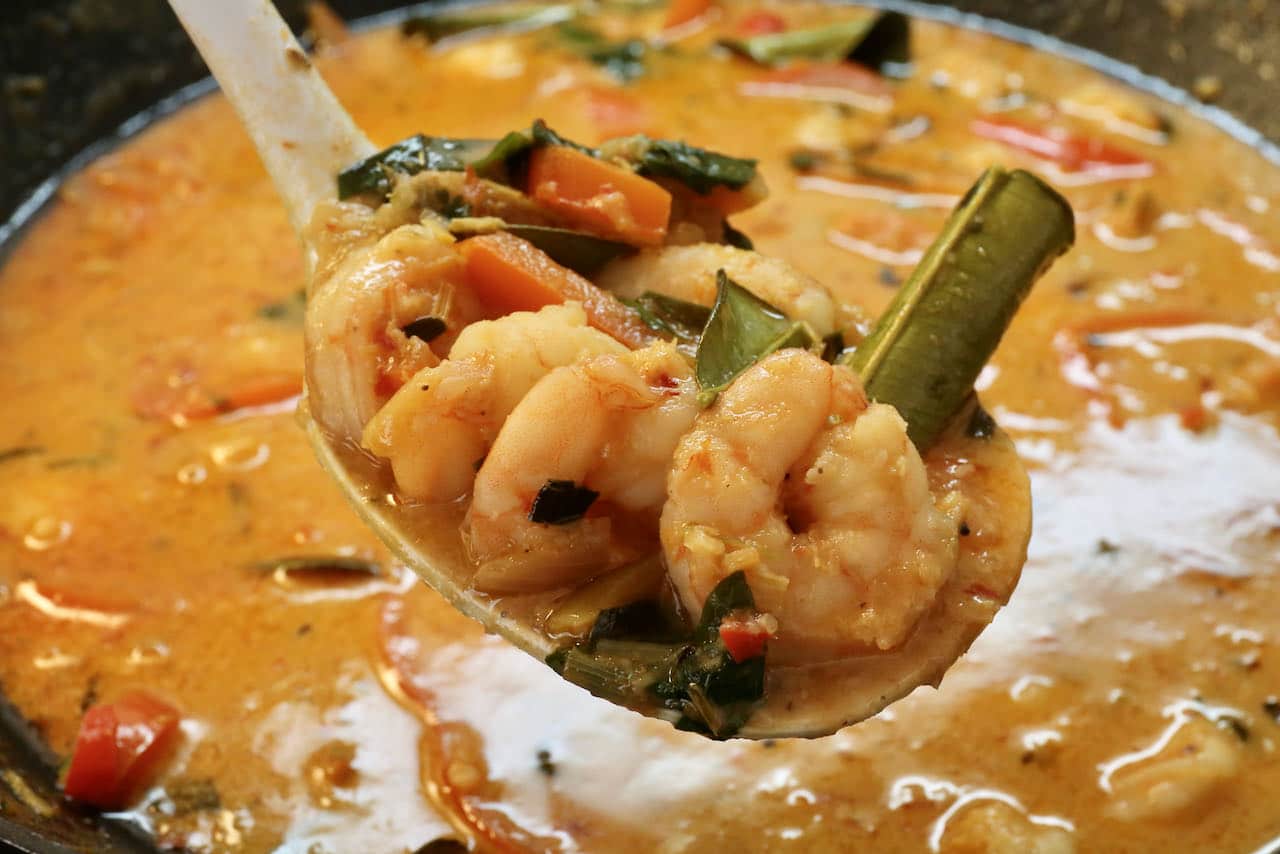
Types of Thai Curry
In Thailand, curry refers both to dishes in Thai cuisine that are made with various types of curry paste and to the pastes themselves. A wet Thai curry is made from curry paste, coconut milk, meat, seafood, vegetables and herbs.
You’ll find unique regional takes on the Thai curry concept in neighbouring countries such as Myanmar, Laos, Malaysia, Singapore, Indonesia, Cambodia and Vietnam.
Popular Thai curries include Green, Red, Yellow, Panang and Masaman. Most Thai curries are categorized by the colour of the curry paste. The colour of the chilies and other ingredients gives each curry its distinct hue. Traditionally, all Thai curries were made with the same ingredients except for one thing: the chilies. Usually green curry is the mildest, red curry is the hottest and yellow falls somewhere in between.
Masaman Curry uniquely influenced Thai cooking thanks to visiting Persian traders. Masaman is a broken translation for Muslim. It originated in the south of Thailand near the border of Malaysia and is a thick sauce with a mild, slightly sweet flavour. Massaman curry dishes distinguish themselves by the inclusion of several whole spices and peanuts.
Panang Curry is sweeter than its sister, spicy Thai Red Curry. It is named for the island of Penang off the west coast of Malaysia and is served sometimes topped with coconut cream.
Most Thai curry paste recipes are made with spicy chilies, garlic, ginger, galangal, lemongrass, shallot, fish sauce, shrimp paste, cane sugar, lime, spices and coconut milk.
We prepared homemade Thai Panang Curry Paste when preparing this Prawn Panang Curry recipe. You can also purchase prepared Panang curry paste online.

Prawn Panang Curry Cooking Tips
This yummy homemade Shrimp Panang Curry recipe is quick and easy to make at home.
- We suggest preparing Thai Prawn Panang Curry in a large wok to reduce splatter when cooking.
- If you want to save time and skip making homemade curry paste you can purchase Thai Panang Curry Paste online or at your local Asian supermarket.
- We’ve deshelled the prawns and shrimp in this recipe but you can keep on the tails to add more seafood flavour to the sauce. They also offer more dramatic eye-appeal when the dish arrives at the table.
- We’ve used red bell peppers in this recipe but you could substitue yellow or orange bell peppers.
- Panang Curry is traditionally made with thick coconut cream. If you’re looking to make a healthier version substitue for coconut milk.
- Authentic Thai curry recipes are sweetened with palm sugar, which is available for purchase at Asian supermarkets. You can substitute for brown sugar as it’s more widely available in North America.
- We suggest using fresh lime leaves but you could also substitute for dried lime leaf.

What To Serve with Thai Curry
Prawn Panang Curry is typically enjoyed as a main dish, served alongside a bowl of steamed jasmine rice.
If you’re hosting a large Thai dinner party, we suggest serving homemade Shrimp Panang Curry buffet-style with other popular Thai dishes like:
- Yum Woon Sen Thai Glass Noodle Salad
- Creamy Red Thai Pork Curry
- Papaya Salad
- Grabong Thai Squash Fritters
- Beef and Pumpkin Curry
- Red Prawn Curry
- Pad Kra Pao
- Thai Red Curry Prawn Burger
- Thai Pork Rib Soup with Vermicelli Noodles
- Egg Tofu Soup with Pork Meatballs
- Gai Pad Med Mamuang Thai Cashew Chicken
- Authentic Massaman Curry
- Nam Tok Authentic Thai “Waterfall Beef” Salad
- Thai Green Curry Chicken
- Thai Pork & Beef Mince Curry Khua Kling
- Khai Jiao Thai Ground Chicken Omelet
- Khao Pad Sapparod Thai Pineapple Shrimp Fried Rice
- Thai Red Curry Prawn Burger
- Chiang Mai Noodles Khao Soi
Creamy Prawn Panang Curry keeps well in the fridge for 2-3 days so store it in an airtight container.
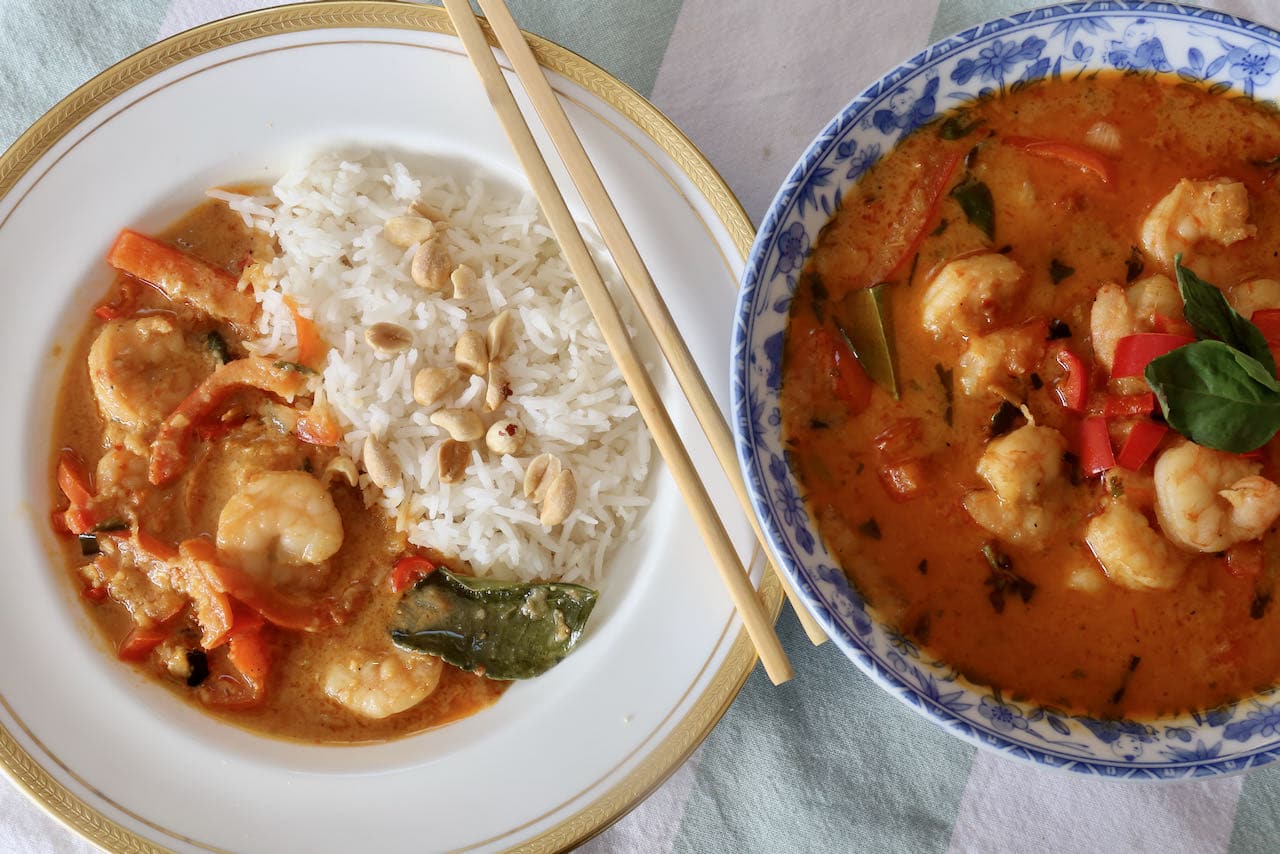
You May Also Enjoy These Seafood Recipes…
- Singapore Chow Mei Fun Noodles
- Garides Saganaki Sizzling Greek Feta Shrimp
- Cilantro Ginger Lime Cajun Shrimp Salad
- Chingri Malai Curry Creamy Bengali Coconut Prawns
- Penang Prawn Noodle Soup Hokkien Mee
- Seafood Laksa: Singaporean Shrimp & Fish Soup
- Cajun Louisiana Cream of Shrimp Soup
- Goi Xoai Vietnamese Mango Salad
- Shrimp & Pork Vietnamese Egg Rolls
- Vietnamese Crepe Bánh Xèo
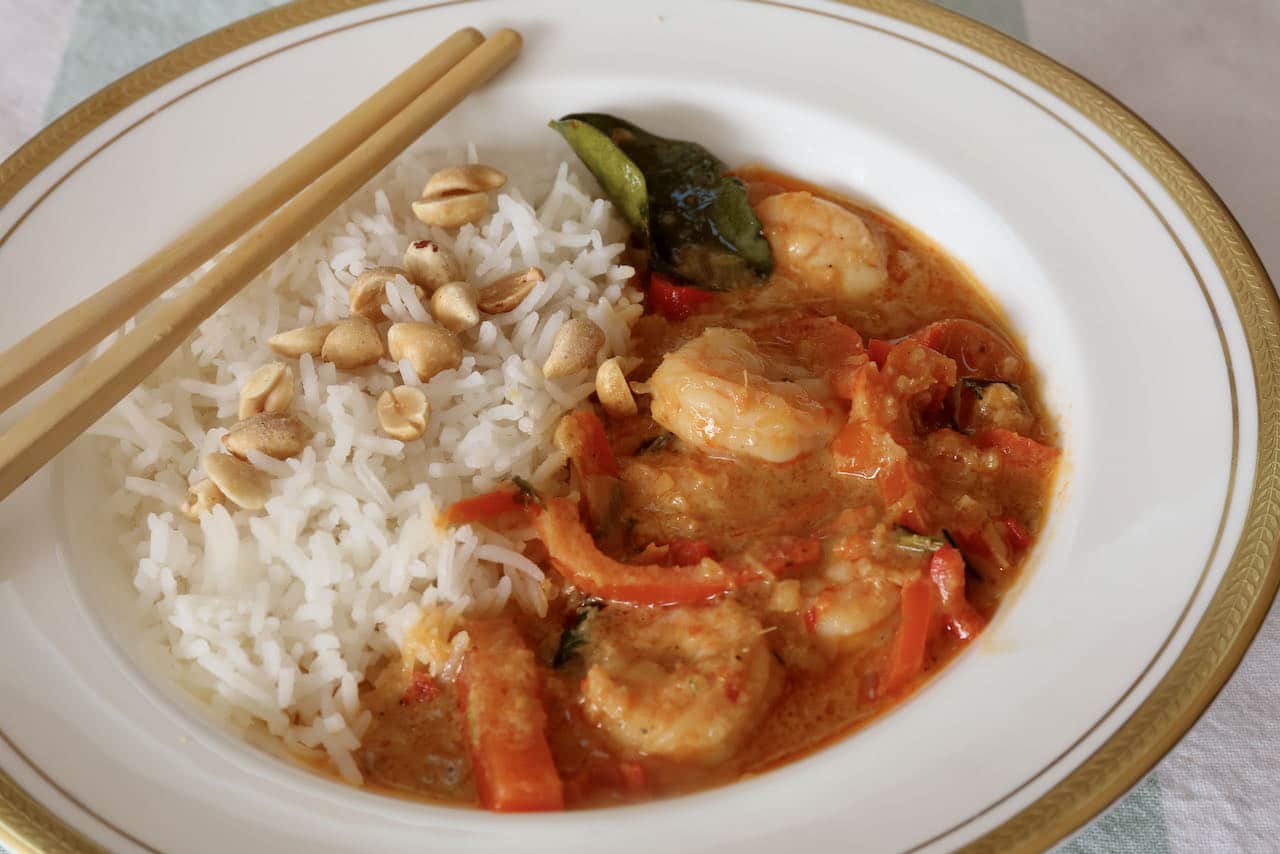
How To Make Traditional Prawn Panang Curry
Thai Prawn Shrimp Panang Curry
Equipment
- Mortar and Pestle
- French knife
- measuring cups
- measuring spoons
- Wok
- Wooden spoon or spatula
Ingredients
Panang Curry Paste
- 10 Dried Chillies deseeded, soaked in water for 10 minutes then chopped
- 1 tsp Kosher Salt
- 1 tsp Cumin Seeds toasted
- 1 tsp Coriander Seeds toasted
- 1/2 tsp White Peppercorns
- 3 tbsp Lemongrass chopped
- 1 tbsp Galangal chopped
- 4 Lime Leaves finely chopped
- 1 tsp Cilantro Root
- 3 tbsp Minced Garlic
- 1/4 cup Shallots chopped
- 1.5 tsp Shrimp Paste
- 2 tbsp Peanuts ground
Shrimp Panang Curry
- 300 g Raw Shrimp
- 1 Red Bell Pepper sliced
- 2 cups Coconut cream
- 2 tbsp Brown sugar
- 3 tbsp Fish sauce
- 7 Lime Leaves
- 1/2 cup Thai Basil leaves
- 1 Red Chili sliced
- 1/4 cup Roasted peanuts
Instructions
Panang Curry Paste
- Soak the chilies in water for at least 10 minutes and up to an hour to soften.
- Using a mortar and pestle or a spice grinder, grind the toasted coriander seeds, toasted cumin seeds, and white peppercorns into a fine powder. Remove and set aside.
- Grind roasted peanuts in the mortar and pestle until fine; remove and set aside.
- Drain the chilies from soaking water and dry off excess water with paper towel. Cut into small pieces. Add chilies and salt to mortar and pestle; pound into a rough paste. Add the ground dry spices to help absorb the liquid from the chilies and continue pounding to a fine paste.
- Add lemongrass, galangal, lime leaf, and cilantro roots. Add shallots and garlic; pound into a fine paste.
- Add ground peanuts and shrimp paste, pound to mix.
Shrimp Panang Curry
- Put half of the coconut cream into a wok and heat over medium high for 3-5 minutes. Stir continuously, until the coconut oil begins to separate.
- Add the Panang Curry Paste and stir for one minute until fully combined.
- Add raw shrimp and sliced bell pepper, cooking for 2-3 minutes until tender.
- Add the remaining coconut cream and bring to boil. Simmer and add brown sugar, fish sauce and kaffir lime leaf. Stir to combine then add half the basil leaves.
- Turn the heat off and serve Shrimp Panang Curry with shredded kaffir lime leaf, sliced red chili, peanuts and remaining basil.
Nutrition
Some of the links in this story use affiliate links. This means that if you make a purchase through our site, Dobbernationloves will earn a small commission at no extra cost to you. Your support helps us to produce comprehensive content.
Save this story to Pinterest!



